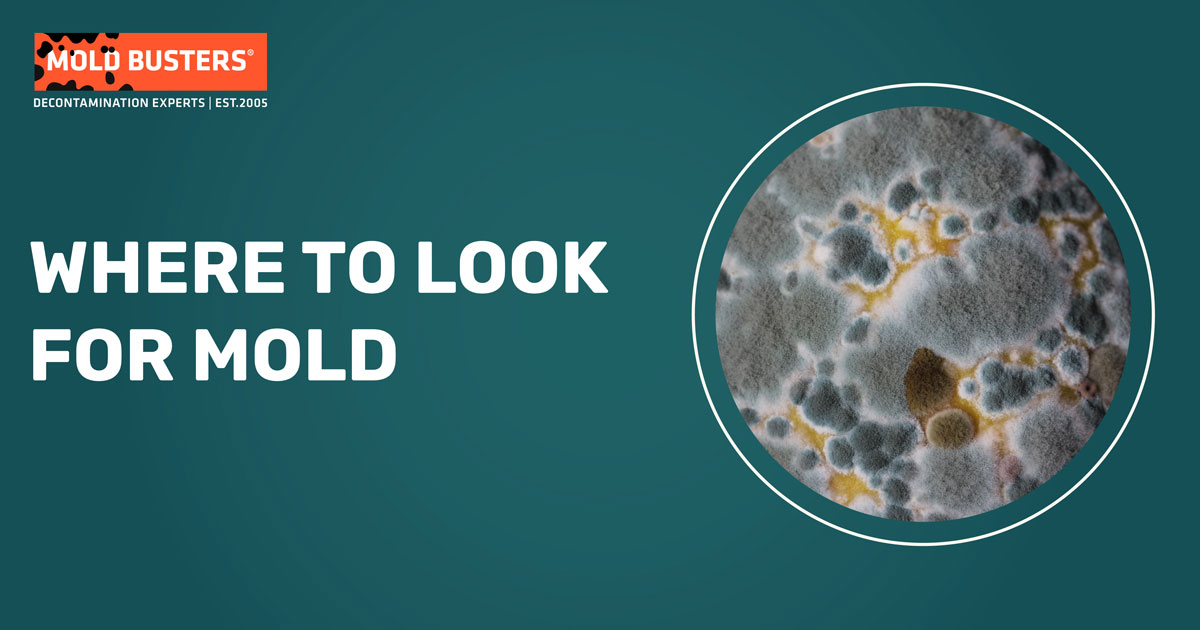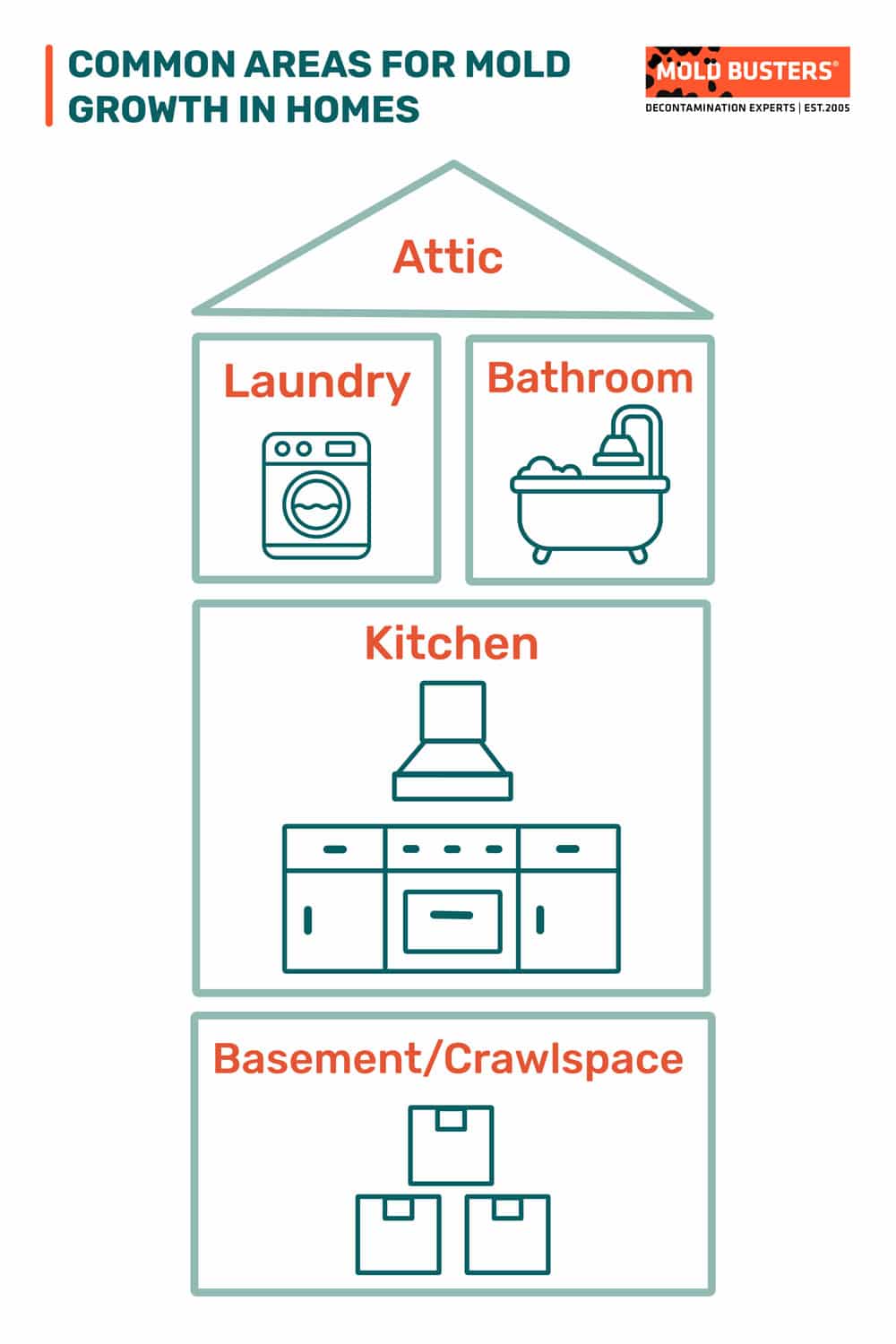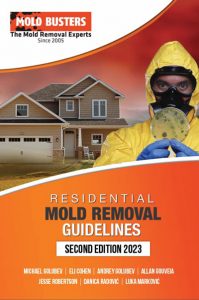Where Does Mold Grow? Common Places for Household Mold
Expert insights from over 20 years of professional mold inspection and detection in Canadian homes
Quick Answer: Mold commonly grows in damp, dark, and poorly ventilated areas of your home. The most affected locations include bathrooms (around showers and under sinks), basements and crawl spaces, kitchens (under sinks and behind appliances), attics with poor insulation, windowsills where condensation accumulates, and HVAC systems. Mold thrives wherever moisture persists, making regular inspection of high-humidity zones essential.

Mold is stubborn, and it can develop almost anywhere in your home. Fortunately, with over 19 years of experience in professional mold inspection and detection, we can help you diagnose your situation! Here are the most critical locations where mold spores hide in homes, plus expert tips to detect and prevent mold growth.
Mold can grow virtually anywhere—in any room of any house, in any commercial building and in any storage room. However, understanding where mold grows most commonly helps homeowners focus their prevention and detection efforts effectively.
Some areas are significantly more prone to mold problems than others, especially in varying climate conditions. Knowing where to look for mold can help you detect, eliminate and prevent costly problems before they spread.
💡 Worried About Hidden Mold? Get a Free Inspection!
Mold can hide in many places in your home, posing risks to your health and property. Don’t let it go unchecked! Contact Mold Busters for a free virtual mold inspection. Our experts are ready to provide a comprehensive assessment and a plan to tackle any mold issue, ensuring your home is safe and healthy. Act now to protect your space!
Where Does Mold Grow Most Often? High-Risk Areas in Your Home
Most Common Mold Locations: homes face unique challenges due to our climate variations, from winter condensation issues to spring moisture problems. These high-moisture areas require special attention as they are prime locations for mold growth.

🏠 Primary Risk Areas:
- Basements: Flooding, leaks, condensation, poor ventilation, cold concrete surfaces…
- Bathrooms: Showering, steam, leaks, inefficient exhaust fans, tile grout…
- Kitchens: Cooking steam, washing, inefficient exhaust fans, under-sink leaks…
🔍 Secondary Risk Areas:
- Attics: Poor ventilation, insufficient air circulation, roof damage, insulation gaps…
- Crawlspaces: Ground moisture, leaks, poor ventilation, organic debris…
- Laundry rooms: Washing machines, dryer vents, humidity, poor ventilation…
💡 Hidden Mold Warning: Despite your best efforts, mold problems aren’t always visible–sometimes they spread behind walls and ceilings or underneath floorboards. This is often the case when there’s a crack in your home’s foundation, a leaky pipe or some other type of water intrusion.
You should also keep an eye out for mold on drywall, carpets, curtains, wallpaper, wood surfaces, furniture, stored food items, plants and potting soil.
Consider hiring a professional mold inspector who can use infrared camera technology to detect hidden mold in inaccessible places without destructive testing. We offer a comprehensive virtual inspection service that can help identify potential mold problems remotely.
17 Specific Places Where Mold Grows in Homes
1. Where Does Mold Grow in Basements?
Basement Mold Facts: Basements are the most common location for mold growth in homes, combining high humidity, poor ventilation, cool temperatures, and frequent moisture intrusion from various sources.
Mold typically grows on concrete basement floors, foundation walls, ceiling joists, and in corner areas where air circulation is poorest. Cool concrete surfaces create condensation when humid air contacts them, providing the moisture mold needs to thrive.
🔍 Common Basement Mold Locations:
- Foundation walls and corners
- Concrete floors, especially near sump pumps
- Behind stored items against walls
- Around water heaters and furnaces
- Near basement windows and window wells
- On organic materials like cardboard boxes

📊 Did You Know?
Only 8% of basements we tested didn’t have any presence of mold?! Find out more exciting mold stats and facts inside our mold statistics page.
2. Where Does Mold Grow in Crawl Spaces?
Crawl spaces provide ideal conditions for mold growth: darkness, dust accumulation, poor ventilation, and frequent moisture exposure. Because homeowners rarely inspect these areas, mold can establish extensive colonies undisturbed.
Crawl space mold commonly develops on floor joists, subfloring, foundation walls, and insulation materials. Ground moisture migrates upward, while dust and organic debris provide food sources for mold spores.
🕳️ Key Crawl Space Inspection Points:
- Floor joists and rim boards
- Subflooring and insulation
- Foundation walls and piers
- Around utility penetrations
- Near vapor barrier edges
- In corners with poor air circulation
3. Where Does Mold Grow in Bathrooms?
Bathroom Mold Reality: Bathrooms experience the highest humidity levels in most homes, making them prime locations for mold growth. Steam from showers and baths creates moisture that settles on surfaces throughout the room.
Bathroom mold commonly appears on tile grout, shower caulking, behind toilets, under sinks, and on ceiling surfaces. Poor ventilation exacerbates these conditions, allowing moisture to persist long after use. Professional bathroom mold removal may be necessary for extensive growth.
🚿 Common Bathroom Mold Locations:
- Shower and bathtub tile grout
- Caulking around fixtures
- Behind and around toilets
- Under bathroom vanities and sinks
- Bathroom ceilings and walls
- Inside exhaust fan housings
- On shower curtains and bath mats
4. Where Does Mold Grow in Kitchens?
Kitchen environments combine cooking steam, dishwashing moisture, and potential plumbing leaks to create favorable mold conditions. Kitchen mold problems often develop in hidden areas where moisture accumulates unnoticed.
Mold frequently grows under kitchen sinks, behind appliances, around dishwashers, and near refrigerators where condensation occurs. Poor exhaust ventilation allows cooking moisture to settle on surfaces throughout the kitchen.
5. Where Does Mold Grow in Attics?
Attic mold results from poor ventilation, roof leaks, or inadequate insulation causing condensation buildup. Attic mold removal often requires addressing underlying ventilation or insulation issues.
Attics face unique challenges from ice dam formation, which can force water under roofing materials. Temperature differentials between heated living spaces and cold attics create condensation on roof sheathing and insulation.
6. Where Does Mold Grow Behind Walls?
Hidden mold behind walls often results from plumbing leaks, exterior moisture intrusion, or condensation within wall cavities. This concealed growth can spread extensively before becoming visible, making professional detection crucial.
Wall mold commonly develops around windows, near plumbing fixtures, behind kitchen and bathroom tiles, and in areas with poor vapor barriers. Wall mold remediation may require selective demolition to access affected areas.
7. Where Does Mold Grow in HVAC Systems?
HVAC systems can harbor mold when condensation occurs within ductwork or when organic dust accumulates on system components. Mold in air vents can distribute spores throughout your home’s air supply.
Mold commonly develops on evaporator coils, in drain pans, within ductwork, and on air filters. Regular HVAC maintenance and proper humidity control help prevent these issues.
8. Where Does Mold Grow Around Windows?
Window areas experience significant condensation, especially during winters when interior humidity meets cold glass surfaces. Window mold issues commonly develop on sills, frames, and surrounding wall areas.
Poor window sealing, inadequate ventilation, and thermal bridging contribute to condensation accumulation. Regular inspection and moisture control help prevent window-related mold problems.
🏠 9. Laundry Rooms
Laundry rooms combine washing machine moisture, dryer humidity, and often poor ventilation to create mold-friendly environments. Mold commonly develops behind washing machines, near dryer vents, and in areas with inadequate exhaust ventilation.
❄️ 10. Air Conditioners
Air conditioning systems create temperature differentials that cause condensation, while circulating dusty air provides food sources for mold growth. Mold in air conditioners requires immediate attention to prevent spore distribution.
🏠 11. Carpets and Floors
Carpet mold problems develop when carpeting becomes wet from spills, leaks, or flooding and doesn’t dry completely within 24-48 hours. Organic carpet fibers and padding provide excellent food sources for mold growth.
🧊 12. Cold Storage Areas
Cold rooms, root cellars, and unheated storage areas common in homes can develop mold due to temperature fluctuations and poor air circulation. Cold storage room mold removal requires addressing both moisture and ventilation issues.
🚗 13. Vehicles
Car mold problems occur when vehicles experience water intrusion from leaks, flooding, or excessive humidity. Winters can create condensation issues when warm, humid air meets cold vehicle surfaces.
🛏️ 14. Bedrooms
Bedroom mold issues often result from poor ventilation, water leaks, or high humidity levels. Common locations include around windows, behind furniture against exterior walls, and in closets with poor air circulation.
🛋️ 15. Living Areas
Living room mold problems typically develop near windows, around fireplaces, behind furniture, or in areas affected by hidden water leaks. Proper ventilation and moisture control help prevent these issues.
🚙 16. Garages
Garage mold issues result from poor ventilation, ground moisture, vehicle moisture tracking, and stored organic materials. Garages attached to homes can transfer mold problems to living spaces.
📦 17. Stored Items
Stored belongings provide excellent food sources for mold when exposed to moisture. Common affected items include books, clothing, cardboard boxes, wooden furniture, and paper documents.
Where Does Mold Grow? Understanding the Conditions
Mold Growth Requirements: While knowing specific locations helps, understanding why mold develops in these areas enables better prevention. Mold requires four basic conditions to grow and thrive in your home environment.
💧 1. Moisture
Requirement: Humidity above 60% or direct water exposure
Most critical factor for mold growth – without moisture, mold cannot survive.
🍽️ 2. Food Source
Requirement: Organic materials like wood, paper, fabric, or dust
Mold feeds on cellulose and other organic compounds found in building materials.
🌡️ 3. Temperature
Requirement: Typically between 40-100°F (4-38°C)
Normal indoor temperatures are perfect for mold growth year-round.
⏰ 4. Time
Requirement: Usually 24-48 hours under favorable conditions
Mold can begin growing surprisingly quickly when conditions align.
Why Does Mold Grow in Basements More Than Other Areas?
Basements combine multiple risk factors that make them particularly vulnerable to mold problems. Understanding these factors helps homeowners focus prevention efforts effectively.
🌊 Flooding Susceptibility
Basements are vulnerable to groundwater intrusion, sewer backups, and foundation leaks
💨 Poor Ventilation
Below-grade spaces have limited natural air circulation compared to upper floors
🌡️ Temperature Differentials
Cool basement walls allow warm, humid air to condense during summer months
💧 Moisture Migration
Without proper moisture barriers or insulation, ground moisture migrates upward through foundation materials
How to Find Hidden Mold: Professional Detection Methods
Advanced Detection: Professional mold inspectors use specialized equipment and techniques to locate hidden mold growth that homeowners cannot detect through visual inspection alone. These methods help identify problems before they become extensive and costly.
🌡️ Infrared Thermography
Detects moisture patterns behind walls and ceilings using thermal imaging technology
💧 Moisture Meters
Measure water content in building materials to identify problem areas
🌬️ Air Quality Testing
Identifies elevated spore concentrations in indoor environments
🧪 Surface Sampling
Tests suspected areas for mold presence and species identification
❄️ HVAC Inspection
Examines ductwork and system components for mold contamination
Our certified inspectors use advanced equipment to provide comprehensive assessments of your property’s mold risk. We offer both in-person and virtual inspection services to meet your needs.
Seasonal Mold Growth Patterns in Homes
Climate Challenges: Homes face unique seasonal challenges that affect where and when mold problems develop. Understanding these patterns helps homeowners prepare and prevent issues before they occur.
🌸 Spring Mold Issues
Spring brings snow melt, increased outdoor humidity, and temperature fluctuations that create condensation problems. Basement mold prevention becomes critical as groundwater levels rise and foundation moisture increases.
☀️ Summer Mold Concerns
High humidity and air conditioning use create conditions for mold growth in HVAC systems and poorly ventilated areas. Basement condensation problems peak when humid summer air contacts cool foundation walls.
🍂 Fall Mold Prevention
Roof maintenance, gutter cleaning, and heating system preparation help prevent winter moisture problems. Proper ventilation becomes critical as homes are sealed for cold weather.
❄️ Winter Mold Challenges
Indoor humidity from heating systems, cooking, and reduced ventilation can create condensation problems around windows and in poorly insulated areas. Ice dam formation can cause water intrusion and attic mold problems.
When to Call Professional Mold Inspectors
Professional Expertise Needed: While homeowners can identify obvious mold problems, professional inspection becomes necessary when dealing with hidden growth, extensive contamination, or health concerns. Our certified professionals have the training and equipment to assess complex situations.
🔍 Consider Professional Mold Inspection When:
- You suspect hidden mold but cannot locate the source
- Multiple family members experience unexplained health symptoms
- Previous water damage occurred in your home
- You’re buying or selling a property
- DIY efforts haven’t resolved the problem
- You need documentation for insurance claims
Our experienced team serves Ottawa, Montreal, and surrounding areas with comprehensive mold testing services. We provide same-day reports and work with government-accredited laboratories for accurate results.
Preventing Mold Growth: Professional Recommendations
Prevention Focus: Effective mold prevention focuses on controlling moisture, improving ventilation, and maintaining proper humidity levels throughout your home. Our experts recommend a comprehensive approach addressing both obvious and hidden risk factors.
🛡️ Essential Mold Prevention Strategies:
- Maintain indoor humidity between 30-50%
- Ensure adequate ventilation in high-moisture areas
- Address water leaks and moisture problems immediately
- Use exhaust fans during cooking and bathing
- Regularly inspect and maintain HVAC systems
- Improve basement and crawl space ventilation
- Install and maintain proper vapor barriers
For comprehensive prevention guidance, explore our resources on how to prevent mold in different areas of your home.
Professional Mold Remediation Services
Professional Remediation: When mold problems exceed safe DIY limits (typically over 10 square feet), professional remediation ensures proper containment, removal, and prevention of cross-contamination. Our remediation services follow industry standards and government guidelines.
We provide comprehensive mold removal services including containment, safe removal, affected material replacement, and prevention recommendations. Our work comes with guarantees and extended warranty options for your peace of mind.
🏠 Ready to Protect Your Home?
If you suspect mold growth in your home, don’t wait for the problem to worsen. Our expert team is ready to help with quick, convenient, and affordable mold inspection services.
✅ 19+ Years Experience
Serving Ontario and Quebec with professional mold inspection and remediation services since 2005
🔬 Advanced Technology
Infrared cameras, moisture meters, and laboratory-grade air quality testing equipment
📋 Certified Professionals
Government-accredited laboratories and industry-certified inspection technicians
💰 Satisfaction Guarantee
Extended warranty options and satisfaction guarantees on all remediation work
📍 Service Areas
Proudly serving throughout Ontario and Quebec:
Disclaimer: This information is provided for educational purposes and should not replace professional assessment. Always consult qualified professionals for mold concerns and safety issues.
Copyright: This content is proprietary and protected by copyright law. Reproduction without permission is prohibited.

Get Special Gift: Industry-Standard Mold Removal Guidelines
Download the industry-standard guidelines that Mold Busters use in their own mold removal services, including news, tips and special offers:
"*" indicates required fields
Published: September 13, 2018 Updated: September 8, 2025

Written by:
John Ward
Account Executive
Mold Busters
Fact checked by:
Michael Golubev
CEO
Mold Busters
